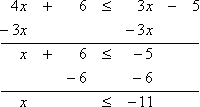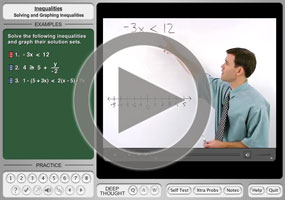Solving Linear Inequalities
Purplemath
How do you solve linear inequalities?
Solving linear inequalities is very similar to solving linear equations, in that you still want to isolate the variable (that is, get the variable by itself), and you accomplish this isolation by adding, subtracting, multiplying, and dividing both sides of the inequality by the same values.
Content Continues Below
The only difference is that, when working with inequalities, you have to flip (that is, reverse) the inequality sign whenever you multiply or divide both sides of the inequality by a negative.
What follow are some simple examples to help you refresh on the techniques and notations.
1) Solve x + 3 < 2
The only difference between the linear equation x + 3 = 2 and this linear inequality is that I have a "less than" sign, instead of an "equals" sign. The solution method is exactly the same: subtract 3 from either side.

So, in inequality notation, the solution is x < −1.
In interval notation, the solution is written as (−∞, −1)
Graphically (that is, on a number line), the solution is drawn as shown below:
Note that the solution to a "less than, but not equal to" inequality is graphed with a parentheses (or else an open dot) at the endpoint, indicating that the endpoint is not included within the solution.
Affiliate
2) Solve 2 − x > 0
The only difference between the linear equation 2 − x = 0 and this linear inequality is the "greater than" sign in place of an "equals" sign.
In order to avoid having a "minus" sign on the variable, I'll add the x to both sides of the inequality.

The inequality-notation solution "2 > x is perfectly valid, but I'm more comfortable having the variable on the left-hand side; it is often easier (for me, at least) to picture what the solution means with the variable on the left. That's why I reversed the inequality above to get x < 2. Don't be afraid to rearrange things to suit your taste.
In interval notation, the solution is all values less than (but not including) 2, which is written as (−∞, 2).
Graphically, the solution is:
Content Continues Below
3) Solve 4x + 6 ≥ 3x − 5
The only difference between the linear equation "4x + 6 = 3x − 5" and this inequality is that there is a "less than or equal to" sign instead of an "equals" sign. The solution method is exactly the same.

So the inequality-notation solution is x ≤ −11.
The interval-notation solution is (−∞, −11]. The square bracket is used here, instead of the parenthesis that was used in the previous examples, because this is an "or equal to" inequality, meaning that the endpoint (in this case, the −11) is included in the solution.
Graphically, the solution is:
Advertisement
4) Solve 2x > 4
The solution method here is to divide both sides by a positive two.
So the inequality-notation solution is x > 2
The interval-notation solution is (2, +∞).
Graphically, the solution is:
Because I had divided both sides by a positive value, I did not flip the inequality symbol.
Affiliate
5) Solve −2 > 4
Had they asked me to solve the equation −2 = 4, I would solve by dividing both sides by the negative 2. I will solve this inequality in the same way. However, because I will be dividing both sides of an inequality by a negative, I must remember to flip the inequality symbol.

So the inequality-notation solution is x < −2.
The interval-notation solution is (−∞, −2).
Graphically, the solution is:
The rule for example (5) above often seems unreasonable to students the first time they see it. But think about inequalities using numbers instead of variables. You know that the number four is larger than the number two:
4 > 2
Multiplying both sides of this inequality by −1, we get −4 < −2, which the number line shows is true:
If we hadn't flipped the inequality, we would have ended up with "−4 > −2", which is clearly *not* true.
URL: https://www.purplemath.com/modules/ineqsolv.htm
You can use the Mathway widget below to practice solving linear inequalities. Try the entered exercise, or type in your own exercise. Then click the button and select "Solve the inequality for x" to compare your answer to Mathway's.
Please accept "preferences" cookies in order to enable this widget.
(Click "Tap to view steps" to be taken directly to the Mathway site for a paid upgrade.)
Select a Course Below
Standardized Test Prep
Homeschool Math
© 2024 Purplemath, Inc. All right reserved. Web Design by ![]()




